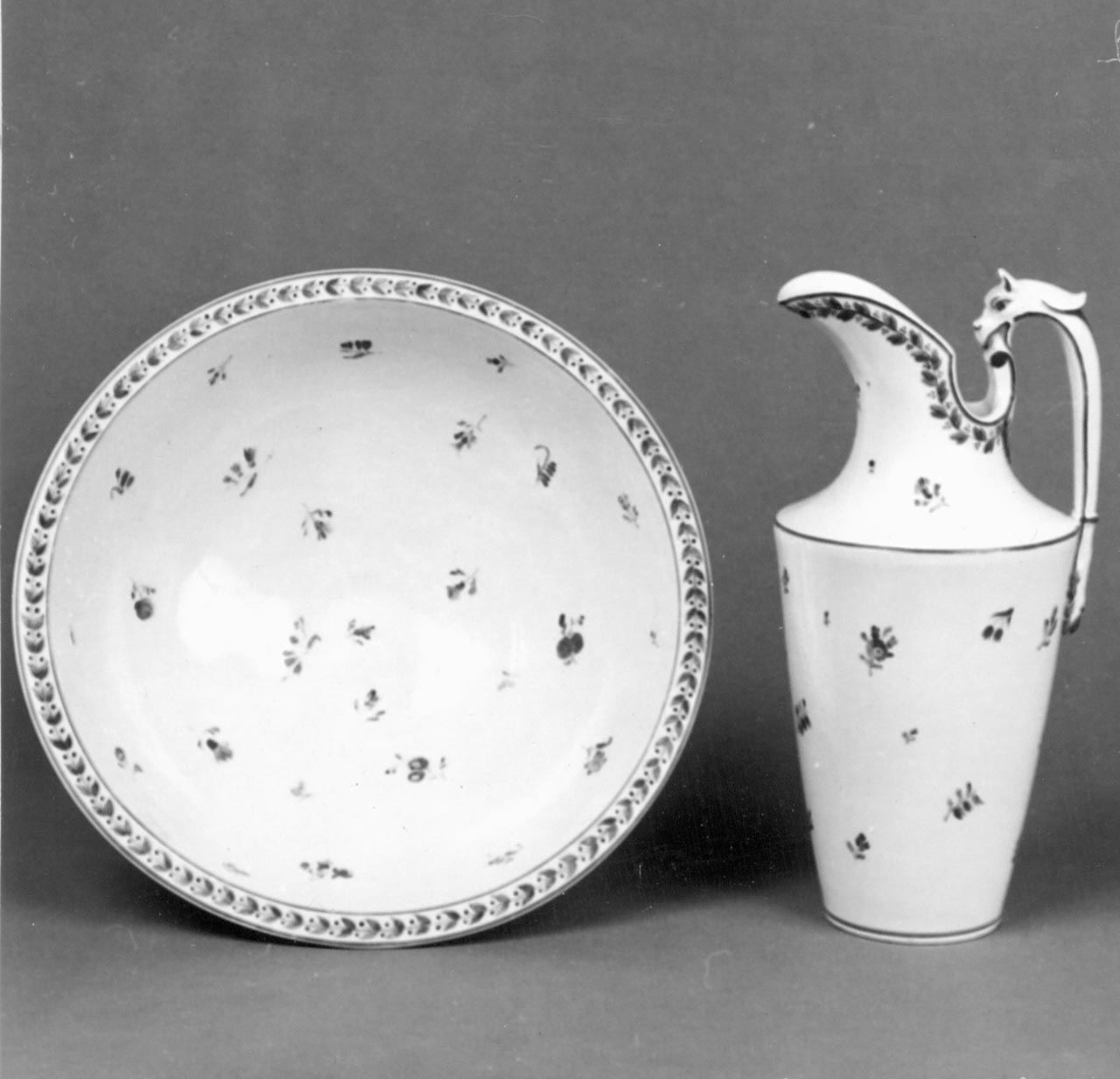🍶 Catinella – Descriptions for Everyone
Picture a bright farmhouse kitchen two centuries ago. On the wooden table sits a small porcelain bowl the Italians call a catinella. This one, catalogued as 0900162643A, was painted in Florence around the early eighteen hundreds. Tiny pink and blue flowers scatter across its white surface, and a rim of green vine—called vitalba—circles the edge like a spring wreath.
What was it for? Before indoor plumbing, families kept basins everywhere: by the hearth for washing hands before meals, on bedroom washstands for face and teeth, or beneath a ewer to catch rinse water when scrubbing laundry. Lightweight porcelain made cleaning easier and, importantly, signalled good manners. A polished catinella told guests that the household cared about hygiene and beauty.
Next time you splash water on your face, remember the journey from painted porcelain to modern taps every single day!
Catalogue 0900162643A, Florence, c. 1810‑1840. Hard‑paste porcelain basin, Ø 25 cm, scatter‑flower enamels and a vitalba garland with traces of fired gold.
Portable wash‑basin for bedrooms and kitchens in pre‑plumbed Italy: light, non‑reactive, easy to scour. Etiquette manuals of the 1830s demanded basin + ewer sets for every guest room—porcelain signalled refinement where pewter meant necessity.
Museums now use the object to discuss domestic hygiene, industrial porcelain, and gendered labour; collectors prize crisp enamels and intact gilding.
Object & Material
Thrown in Florence between 1810 and 1840, this hard‑paste porcelain catinella (Ø 25 cm) carries
over‑glaze bouquets fired around 780 °C and a sponge‑stamped vitalba border. A whisper of gold
still hugs the rim.
Hygiene Revolution
Doctors preached daily washing decades before plumbing existed. Basins like this turned advice into
action, sitting on wash‑stands, kitchen dressers, or guest tables. The light, glossy body resisted
stains
and made scouring quicker than with copper or tin.
Workshop & Trade
Ginori wage books list decorators paid per “fiorellini sparsi”. Cobalt from Saxony and chrome green from
Vauquelin’s mines coloured the design, while rail links let finished wares reach farmhouses from
Piedmont
to Puglia.
Social Semantics
Owning porcelain signalled cultural capital. Diaries tell of brides packing a basin as dowry and of
travellers finding fresh rose‑water waiting in guest rooms—a tactile welcome long before hotels offered
toiletries.
Legacy
Today conservators stabilise craze lines with Paraloid B‑72 and scan every curve for VR teaching kits.
In
cottage‑core décor and indie‑game props, the catinella still reflects morning light and stories
of care.
🛁✨ Vintage vibes incoming! Meet the catinella—a hand-painted porcelain basin from Florence, catalogue 0900162643A. Think scattered rosebuds on a snow-white glaze, rimmed with a green ‘vitalba’ vine and a whisper of gold. Made early 1800s, still stealing scenes.
✅ What it did: before running water, this bowl sat on washstands so you could splash your face, rinse veggies, even cool wine bottles. A portable slice of hygiene plus instant table decor.
🧠 Fun facts
1. The ‘vitalba’ border copies wild clematis leaves Italians weave into Mid-August wreaths.
2. Porcelain basins were lighter than copper, meaning fewer cracked floorboards in farmhouses.
3. Some emigrants carried basins to Argentina for shipboard shaving—talk about carry-on culture!
⚠️ Handle alert: green enamel hides trace arsenic, so museums glove up. At home stick to display, not dish-up.
🎨 Remix prompts
• Use AR filters, place the basin in your kitchen, then compare real vs virtual shine.
• Voiceover the basin’s journey: kiln, carriage, farmhouse, theatre, metaverse.
• Challenge friends: one-minute reel washing something symbolic—ink-stained quill, VR controller, garden
strawberries.
🌍 Museums share pieces like this, so posting keeps craftsmanship alive. Splash responsibly and keep heritage trending!
| Subject | catinella |
| Title | catinella |
| Type | catinella |
| Description | Catinella dipinta a fiorellini sparsi su fondo bianco. Bordura decorata a foglioline verdi (“vitalba”) |
| Coverage | Firenze (FI) |
| Rights | proprietà Stato |
| Source |
CatalogueRecordOA, Catalogo Beni Culturali |
| Reference | Catalogue Record n° 0900162643A |
| Date | ca 1800 – ca 1849 |
| Format | porcellana / pittura / doratura |
| Documentation | Sources & photographic documents linked to 0900162643A |
| Technical status | Technical status of cultural property 0900162643A |
